As an Amazon Associate I earn from qualifying purchases.
Brining olives is the oldest way to cure olives, especially green ones. What follows are instructions and troubleshooting on how to cure olives with a brine. There are other ways I’ll get to below.
This post assumes you have access to fresh, green olives off the tree, which are pretty but inedible — they are impossibly astringent. Olive trees can be found all over California, in many parts of Arizona, as well as Australia and, obviously, the Mediterranean, where they are native.
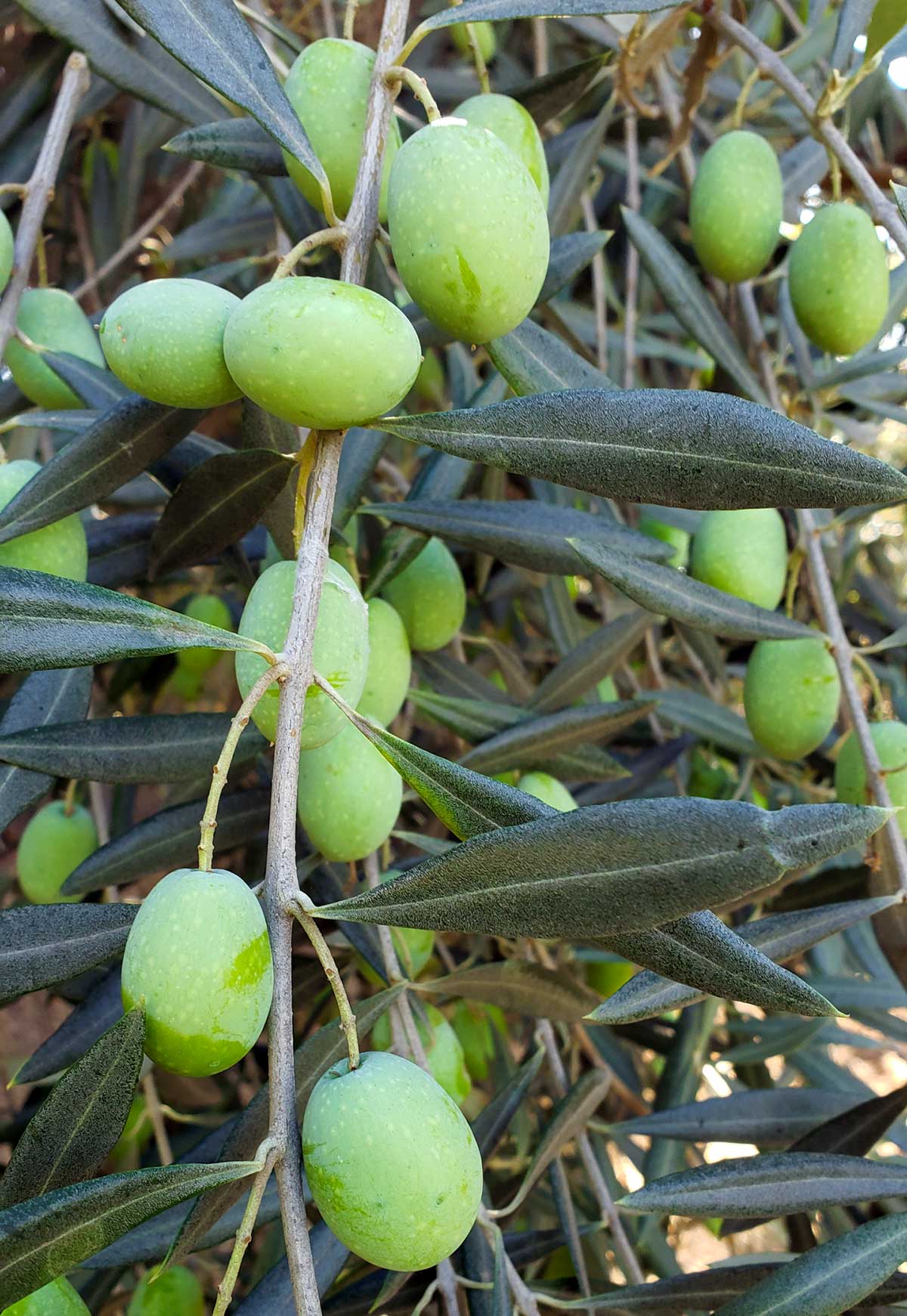
You can buy fresh olives online, and over the years I have provided links, but these companies seem to come and go quickly, so I don’t do that anymore. Just Google “buy fresh olives” around September here in the United States, and I think March in Australia.
The timing is important because you want fresh green olives. And yes, like peppers, all olives start green and ripen to another color, usually black in the case of olives.
Green, unripe olives are firmer and way more astringent than ripe ones. Brining olives when they are green is a great way to cure them, and green olives are the only olives suitable for what, admittedly, is my favorite cure, which a lye cured olive. That process, believe it or not, has been used for 2000 years, and is not as scary as it sounds.
You can brine ripe, black olives, too, just so you know.
My general rhythm is to cruise my local parks in late September or early October; they are full of olive trees, remnants of pre-suburbia orchards around here. On some crisp autumn Saturday, I go picking. Look for pretty olives, with few or no blemishes, and which are not wrinkled.
Tiny dots on an olive are OK, but many may be rotten with olive fly, whose larvae burrow into olives and leave a beige scar where they entered. that telltale scar means there is a visitor lurking within your olive.
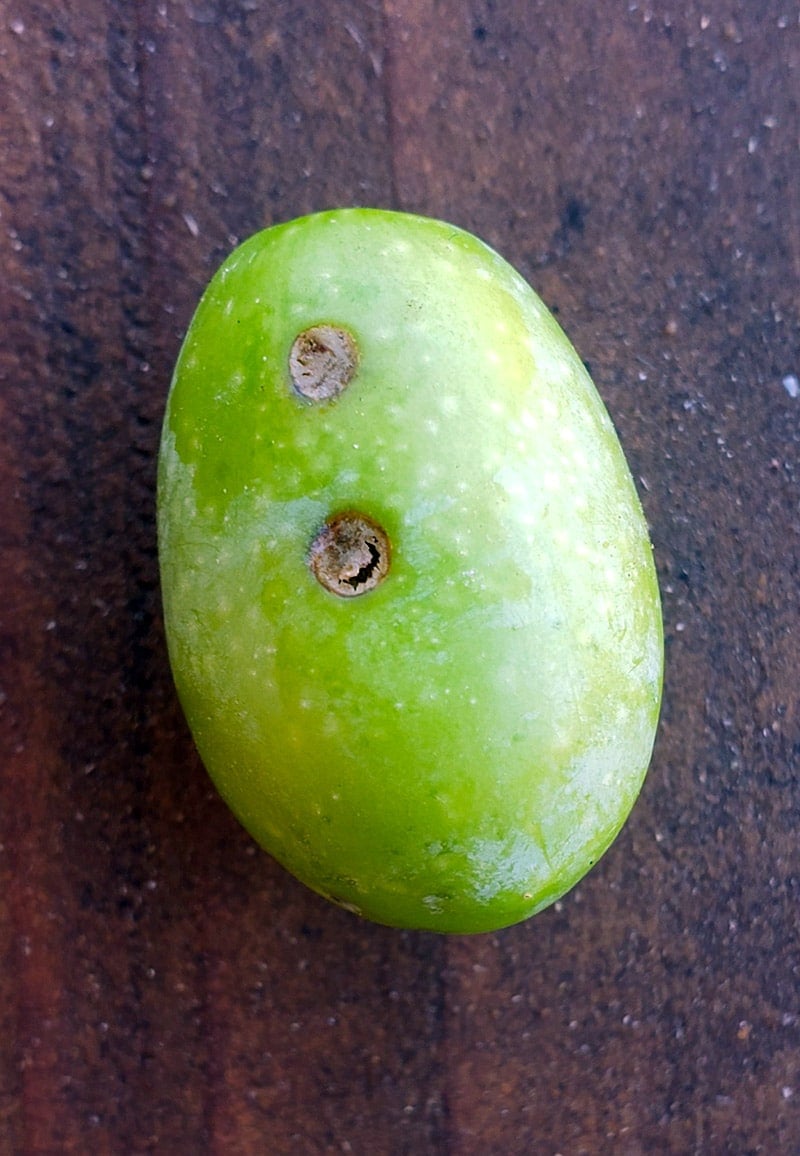
Another hazard are the dry olives. Trees forced to live by their own wits — away from regularly watered grass — are stressed, and their olives shrivel early. Shriveled olives are usable, but they bruise rapidly and don’t make a clean green olive.
When you get home, separate your olives into small, medium and large olives — it doesn’t matter what variety they are, as I don’t know how to tell the difference. If you don’t have enough large ones to make its own batch, mix them with the mediums.
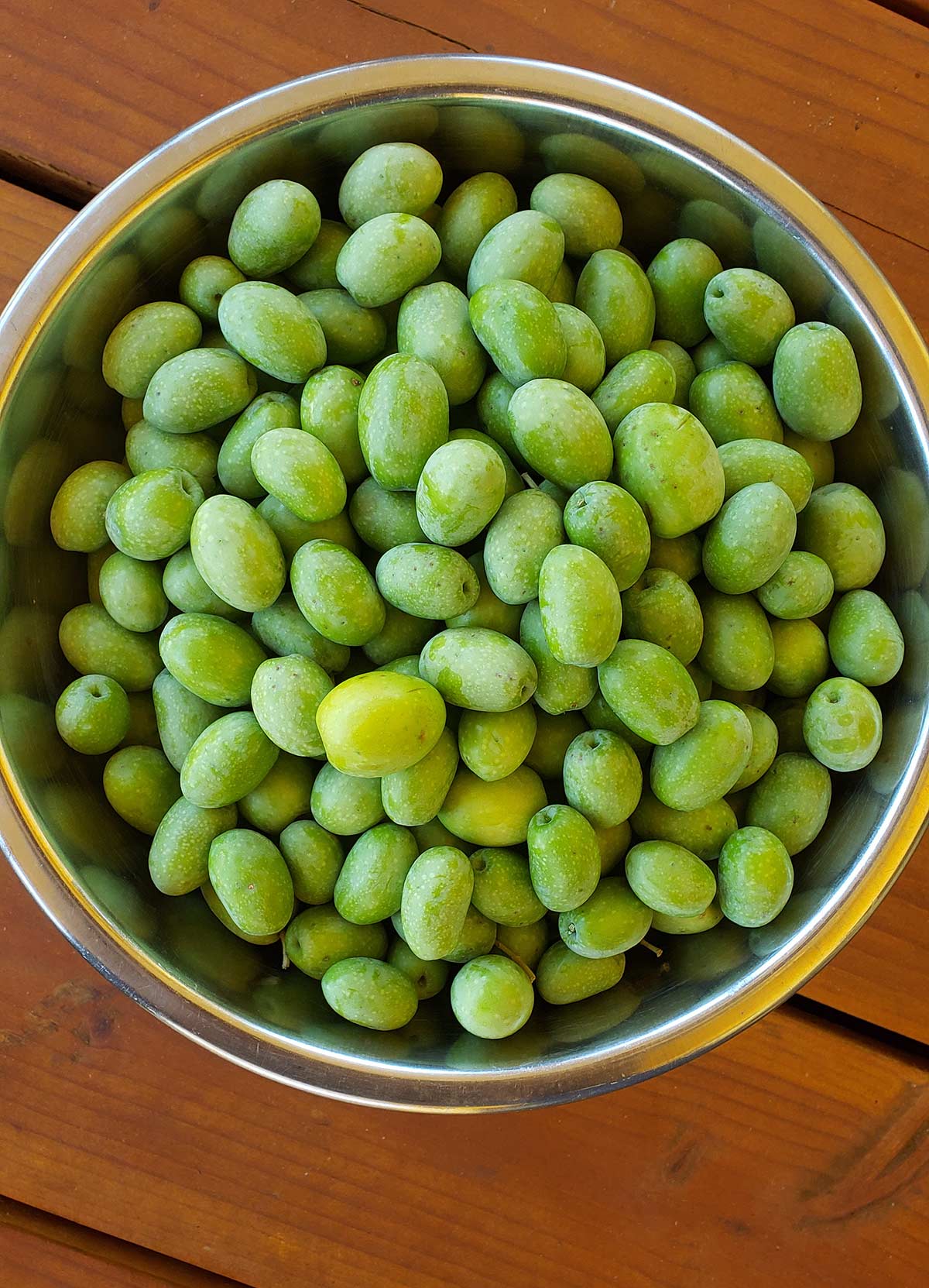
Unless I am doing the lye cure, brining olives is my preferred method, as it is low-maintenance and results in a super-tangy, salty olive that keeps for more than a year and cries out for beer or ouzo. And I like ouzo. A lot.
Brine-curing is easy, but takes a long time. You make a brine of 1/4 cup kosher salt (I use Diamond Crystal) to 4 cups water, plus 1/2 cup of vinegar: white wine, cider or simple white vinegar. Submerge the olives in this brine and top with cheesecloth or something else to keep them underwater. Do not cut them.
Cover the top of the container loosely (I use large, 1 gallon glass jars) and put the jar in a dark, cool place. That’s it. Check it from time to time — meaning every week or so at first. The brine should darken, and you might get a scum on the top. That’s OK.
What’s going on is that your olives are fermenting; it is the fermentation that breaks down the oleuropein over time. The what? Yeah, oleuropein is the astringent substance in an unripe olive. It needs to go if you are going to eat one. Fermentation is why I never wash my olives before curing — I want those natural yeasts on the outside of the olive to do their magic.
I change my brine every month or two, when it begins to look extra nasty. I don’t re-rinse the olives, during changes, either, because I want the residue to act as a “starter” to get the next batch of brine going.
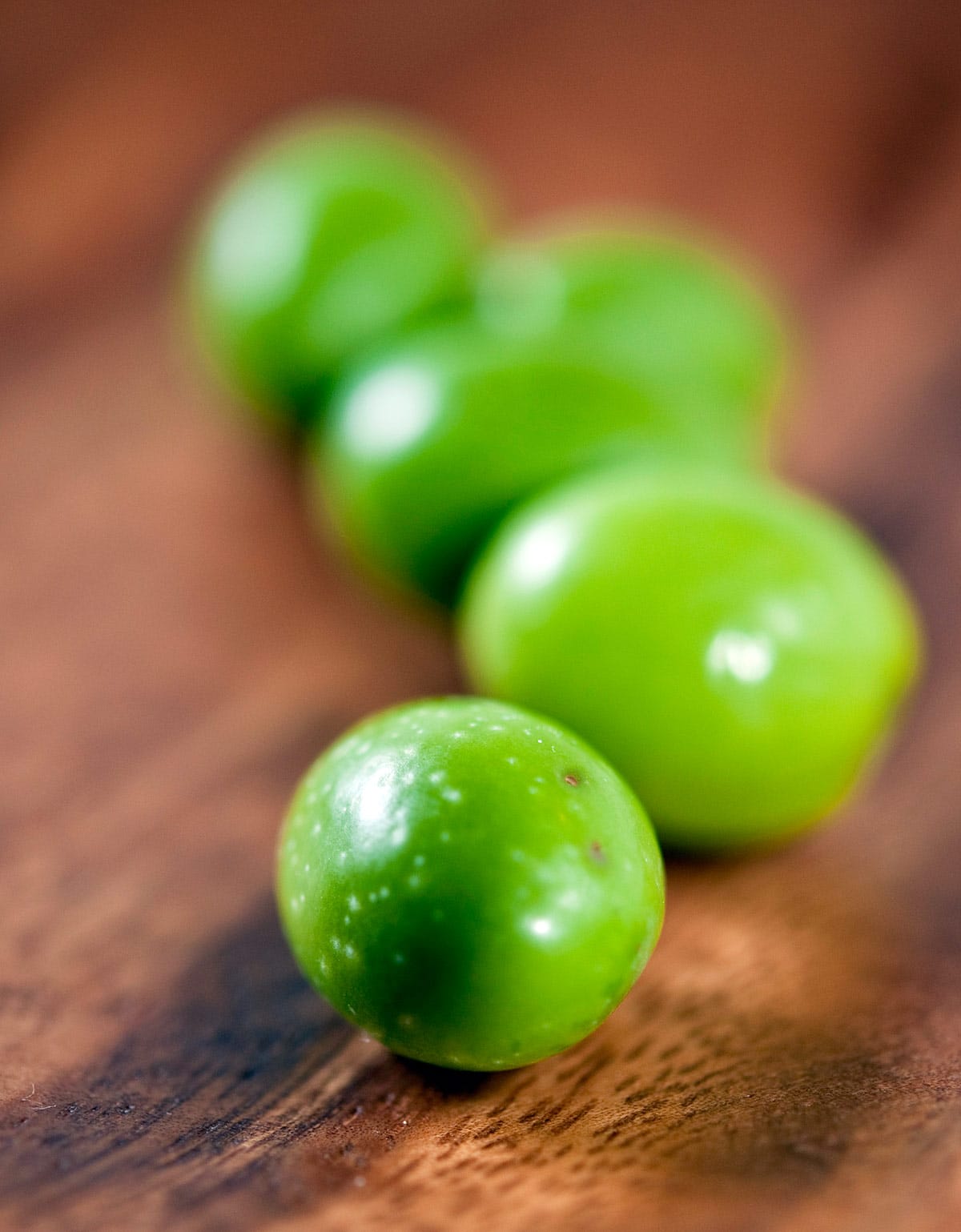
Keep in mind you will be in for the long haul: Olives picked in October are typically ready to eat in May or June. It’s a lot like making wine.
Add seasonings after the New Year, or even later, otherwise you risk too much spice and not enough olive flavor; this is especially true of chiles. If you find you’ve gone too far, change the brine and don’t add new seasonings, and let it steep for a few weeks. That should calm things down a bit.
Once the olives are finished, there is a certain show-off factor when you pull out a plate of olives you cured yourself. “These are your olives? Wow.” Plus, you can flavor them any way you like, which is a bonus.
If you’re too late for green olives, I really like salt cured black olives, which we all call oil-cured olives since that’s how they are stored. If you want to cure black olives, my method is to oil-cure olives.
Brine Cured Green Olives
Ingredients
- 4 pounds fresh green olives
- 1 cup kosher salt
- 1 gallon water
- 1 cup distilled vinegar
Instructions
- Assuming you've already checked your olives for worm scars (see headnotes), discard any with too many blemishes. Place the olives in a stoneware crock or large glass jar with a lid carefully. Fresh olives actually do bruise easily.
- Mix the vinegar, salt and water together. No need to boil, as it will dissolve at room temperature. Pour this over the olives, making sure they are submerged by at least 2 inches. Add more brine in the same ratio if need be.
- Chances are the olives will float. You need to keep them away from air, so I put a plate over them that is just about the size of the jar or crock. You can also use a plastic bag filled with water to keep the olives away from air. Once the olives are submerged, cover the jar or lid (lightly screw on the top if there is one) and place the container in a cool, dark place. A basement is ideal. You don't want them to ever get beyond 75°F if you can help it, because at higher temperatures the olives can go soft. Since this is a wintertime cure, it should not be a problem. Low temperatures are fine, just don't let them freeze. Let them sit for several months.
- As time passes, you will see a scum of mold and weirdness form on the top. This is normal. Skim it off once a week and you'll be fine. At some point the brine itself will get pretty icky. I like to change the brine every month or so, but this is not strictly needed. The olives are done when they are no longer bitter, anywhere from 2 to 4 months.
- Only now do you add other seasonings, like chile peppers, black peppercorns, herbs or citrus peel. Do this in a fresh brine, and let this new, flavorful brine sit 2 weeks before serving. Store the olives in this brine, in a cool place or refrigerator, for up to 2 years. I keep them in quart Mason jars.
Notes
Flavor Additions
- dried chiles
- bay leaves or similar aromatic leaves like citrus leaves
- thyme, sage, oregano, rosemary
- allspice, black peppercorns, juniper berries
- smashed garlic cloves
Nutrition
Nutrition information is automatically calculated, so should only be used as an approximation.

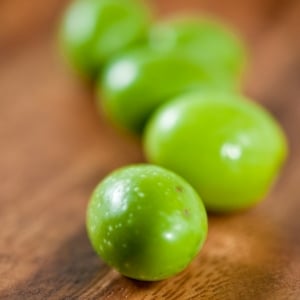




I love olive trees. And olives. So when my husband and I bought a house a year ago I planted three (I know I’ll probably regret it later, or start my own olive oil business). In the meantime, though, I’ve found a few olive trees in a local park that I have been raiding and experimenting with. I’ve used this article as a go-to for it, so I figured I’d post my results.
Water-cured: I tried a jar in the fridge and one in the cabinet. The cabinet cured ones were ready in about 5 weeks, while the refrigerated ones were still super bitter, so I pulled it out and tossed it in the cabinet also (I was impatient).
Salt/vinegar Brine: I reread the article and *just now* noticed it said not to cut the brined olives. I cut them and 4-5 weeks in they are almost ready to eat. I’ll give them one more week then I’ll to put a fresh brine on them and some herbs and peppercorns, maybe some lemon peel.
Salt only brine: Another site suggested this. I started these a week after the other brined olives, and they seem to be coming along about the same pace, although they’ve wrinkled a bit, so we’ll see what the final product looks like.
Oil cured: these ones supposedly take forever,, so it’s a total experiment.
I picked olives from trees in a public area, alongside a road. Should these be washed first? Also, the tree had green olives, purplish-black olives and everything in between. Should I only use the totally green olives? Some are starting to blush into the purple color that will turn black.
Eve: Use only the green olives. Yes, wash them.
I’m feeling a little bit at sea, and am hoping for a little advice. We fell in love with wonderful olives we had in Morocco a few years ago, and in a late-night moment of “I-have-all-the-free-time-in-the-world” madness, I bought some green olives, and hunted around the internet. I opted to water cure them, and a month later I’m content.
I’m not clear, though – I can divvy these up (17 pounds was the smallest order I could make) into different glass containers, that’s fine. BUT, if I follow some sort of brine (storage) recipe, how long do they sit for? I’ve read articles that say put some olives in what seems to be a reasonably weak brine solution, and then add assorted spices. Ok. But then when are these green olives ready to eat? I’d leave anything I canned to mellow for a couple of weeks, but have also read to leave them sit in the brine and spices until spring or early summer.
I think I’ve been canning for so long that my reflexes are off with olives. I’m uneasy about leaving something open (ie not vacuum sealed) for months on end, and other than Morocco, my olive experiences have been with industrial varieties, which I haven’t particularly liked. The Moroccan ones were fresh tasking and lively, in part the spices, but in part I think not lye cured. They tasted fresh and new. Like lovely tiny carrots and baby eggplants from your garden. Not heavy and processed.
Sorry, long post. Any ideas to guide me?
Patricia: You can eat the olives as soon as you can eat the olives, if you know what I mean. It’s a bitterness thing. The brine and spices make them better, but they will always evolve in the jar. And you’re fine not canning them. They will change over time, fermenting a bit, but the brine is your savior. Freshness in olives is a product of either winter olives (eating them right after they’ve cured), or those cured with lye, which is an ancient tradition.
When adding spices how much is enough?
Tammy: Up to you. Remember you can always add, but you cannot subtract.
Hi Hank,
We are using your recipe for the 17 lbs of olives we purchased from Chaffin Orchards. We are going to jar them up today. How much of the brine do you think we should make up for that many olives? Should we just make up a batch as we go along?
Thanks!
For the brine only method do you still have to cut the olives?
Lisa: No.
attempting the water only cure. The olives are starting to go to olive-y color, with some significantly darker around the cuts, but I notice some bubbly/fizzy action in the jars. Some sort of fermentation I guess. I haven’t seen mention of fizz/ferment in the water only ones, so I’m wondering if I took a wrong turn.
Thoughts?
Caordelia: I do this in the fridge. I am guessing you aren’t? Shouldn’t be any fermentation in the fridge…
Hi,
I’m curing my first ever green olives. I’m using Sevillas, and sliced a slit in each olive, then placed them in water. I’ve been soaking them in water for almost two weeks now, and they are somewhat less bittern than when I started. They are very crunchy, although they are starting to turn olive green on the slit half and are softening a bit. I’m assuming the color evens out over time. My question is, how long does it take for them to soften up a bit so they aren’t so crunchy to eat?
I was in Cyprus this summer and loved their home cured olives. They claim to only soak for ten days, then go straight to the brine and they’re ready to eat. But their olives were quite a bit softer than what mine are right now. Although by July, their olives had been curing for several months. Hmmm.
Thanks for the information, and any hints about how long until they soften up are appreciated!
Susan: Your olives were clearly very unripe. They’ll cure eventually, but you’ll need to give it more time.
I bought a 17lb box of green olives, sliced them all once and put them in water in 4 1 gallon jars. My fridge isn’t big enough so I put them on the counter. After a week they were still bitter but obviously less so. I put a quart in brine and vinegar and that flavor reduced the bitterness. After 2 weeks the bitterness in the olives soaking in water was almost completely gone, although I do like a bit of it so may be biased. I could eat them just like this but I just some in 4 quart jars with brine, 1 with lemon juice, 1 with lemon and garlic, 1 with tangerine balsamic, 1 with brown rice vinegar. I will taste them tomorrow and then try herbs also. I can’t wait to try curing ripe olives. Thanks for all the info.
Can you split the brined cured for a faster result?
John: Not that I am aware of.
Thanks for the quick reply, Hank. I’ll get started on them now. Cheers!
I bought 30 lbs. of green Sevillano colosal olives from Penna Great Olives. $100.00 including shipping. They arrived in perfect condition. I cure them in lye using my dad’s old recipe. Awesome every time.
Hi Hank,
I got a bunch of delicious green olives to cure. Thanks for the recipe.
I was also confused about the write-up. It could use a transitional sentence or a header between the water vs salt cured. And one thing that wasn’t clear to me–are the (cut) water-cured olives ready to eat at the same time as the (uncut) salt-brined olives?
Thanks,
Matt
Matt: Nope. Water cured, with the cut, are ready much faster, but they are tricky and get oxidized easily. Brine cured take months, but are easier and last longer.
Thanks for the article, Hank. I just recently moved to Fairfield in and have been wanting to jar my own olives. Can’t wait to try this.
Thanks for your recipe! I found some olives from an online producs website (I’ve ordered other stuff from them before). I am however concerned about the olive fly. How do you tell if it’s just a dot or blemish vs. the work of the fly infestation? I want to be sure but I don’t want to throw any good olives away on accident!
Ash: There is a telltale mark I have a picture of in the post. Memorize that mark.
Dear Hank,
One of the most exciting things about recently moving to northern California was seeing that olives grow here. I grew up in Buffalo N.Y. Italian/Sicilian community and have since been in love with green cured olives! I want to cure my own but have not been able to find them fresh. I’m not even sure when they are harvested. Would you be able to point me in the right direction? Thank you!
Stephanie: Look in public parks here in the Sacramento area, or farmer’s markets. Or you can get them online and they’ll ship overnight.
I followed these instructions exactly and my green olives were fresh. However after the 1st week in brine my olives are going brown just where they have been cut. Is this normal?
Andrea: You cut brined olives? You’re not supposed to. You cut water-cured olives. Those do brown very easily, alas. I rarely make them that way any longer.
I made a batch of brined olives (with lemon, ginger, dried chiles, and bay leaves) two Octobers ago and they are still sitting in my basement.. They smell fine, there is some scum on the top and a few active bubbles. When I open the airlock lid it releases a little bit of pressure but nothing explosive. Do you think they are still okay for consumption? Is there anything I should be looking for that would a major DO NOT EAT sign?
Grace: Hmmm… I might toss them, because they could be mushy, even if safe to eat.
I have been changing the brine every day as per another sites instructions. However my oliives have gone wrinkley and are a bit discoloured. They started out like yours but now have brown marks almost like bruises. Should I continue or discard them?
Hi, can you please tell me if the water cured olives need to sit in the brine for a certain length of time before they are ready or is this just to preserve them? Also, with the brine cured olives, do you need to slice these as well or just put them straight in the brine mix?
Helen: Water cured olives need about a week in brine before eating, but it is all about preserving them afterwards. Brine cure olives do not need to be sliced.